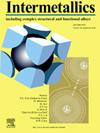Charpy impact behavior and fracture mechanisms in cost-effective ferrous medium-entropy alloy at ambient and cryogenic temperatures
IF 4.3
2区 材料科学
Q2 CHEMISTRY, PHYSICAL
引用次数: 0
Abstract
The cost-effective ferrous medium-entropy alloys (MEAs) exhibit excellent quasi-static tensile property especially at cryogenic temperature, whereas their impact property under high loading rate is still unclear. In this work, the tensile and Charpy impact behaviors of Fe62Co5Ni10Cr13Si7Al3 (at. %) ferrous MEA have been thoroughly investigated at 298 K and 77 K, respectively. The tensile mechanical response shows that as the temperature decrease from 298 K to 77 K, the prepared ferrous MEA comprising 86 vol% face-centered cubic (FCC) phase and 14 vol% body-centered cubic (BCC) phase shows significantly improved yield strength from 986 MPa to 1252 MPa and tensile strength from 1186 MPa to 2016 MPa, along with a comparable ductility. While outstanding combination of impact toughness and yield strength outperforms most other metallic materials, it is undeniable that the impact absorbed energy sharply decrease from 95.5 J at 298 K to 32.2 J at 77 K. The substantial reduced plastic zone ahead of crack tip coupled with the transition of micro-fracture mechanism from ductile dimples to a mixture of dimples and cleavages, which is not conducive to energy consumption during crack propagation, is responsible for the reduced impact toughness.
求助全文
约1分钟内获得全文
求助全文
来源期刊

Intermetallics
工程技术-材料科学:综合
CiteScore
7.80
自引率
9.10%
发文量
291
审稿时长
37 days
期刊介绍:
This journal is a platform for publishing innovative research and overviews for advancing our understanding of the structure, property, and functionality of complex metallic alloys, including intermetallics, metallic glasses, and high entropy alloys.
The journal reports the science and engineering of metallic materials in the following aspects:
Theories and experiments which address the relationship between property and structure in all length scales.
Physical modeling and numerical simulations which provide a comprehensive understanding of experimental observations.
Stimulated methodologies to characterize the structure and chemistry of materials that correlate the properties.
Technological applications resulting from the understanding of property-structure relationship in materials.
Novel and cutting-edge results warranting rapid communication.
The journal also publishes special issues on selected topics and overviews by invitation only.
 求助内容:
求助内容: 应助结果提醒方式:
应助结果提醒方式:


